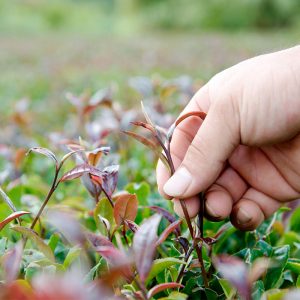
Lately I’ve been hearing about purple tea from Kenya.
I haven’t tried it, but from what I know there are other cultivars of the tea plant that exhibit a red and purple color as well.
One of them is Sunrouge.
History of Sunrouge
Did you know that tea can be made not only from Camellia sinensis, but also from other species of the same genus?
Whether it tastes good or not, that’s another matter. But in practical terms, you can make tea with those leaves.
One such plant is the Camellia taliensis, which is still being used in Yunnan for tea making.
In Ibaraki prefecture, a Camellia taliensis plant was crossed with a Camellia sinensis cultivar named Okumusashi.
Out of that hybrid, a cultivar was developed: Chachuukanbohonnou 6 (茶中間母本農6). It’s a complicated name, I’ll loosely translate it as “intermediate female tree, agriculture number 6”.
This cultivar has a high anthocyanin content (more about that below), but it’s hard to cultivate and has low growth.
To overcome that problem, different seeds from natural crossings of Chachuukanbohonnou 6 were selected and nurtured in 2001.
Much later on, the best tea plant was selected. Its name is Sunrouge and it was registered in 2009.
The company Nippon Paper Industries was involved and had a patent until 2013.
This cultivar has a higher anthocyanin content than Chachuukanbohonnou 6.
The explanation of the name is as follows. Rouge is red in French, and so the image is a red bud reaching out to the sun as if it was a lipstick.
This cultivar isn’t meant for drinking as any other Japanese tea. It’s more of a functional drink, so the name has a modern aspect to it.
About anthocyanins
These polyphenols found in plants are water soluble pigments that range from red, purple or blue depending on the pH.
Eggplants, blueberries, raspberries, pomegranates, and many other fruits owe their color to this compounds.
There seems to be health benefits associated, which is the reason why anthocyanin rich teas were developed in the first place. However, I’ll leave that for another occasion, otherwise this post would be too long.
Note that anthocyanins won’t make a better tasting tea, so there’s a tradeoff involved.
Characteristics of Sunrouge
The buds reach a red/purple tone at their peak, but they will lose that color if not harvested that day.
It’s a normal budding cultivar, which can be picked at about the same time as Yabukita.
It’s strong against anthracnose, and very strong against the grey blight, but weak against the white peach scale.
By adding an acidic liquid (hence lowering the pH) such as lemon juice, the brewed tea will change color.
I’ll tell you more about its taste in the next post.
Sources:
http://www.naro.affrc.go.jp/publicity_report/press/laboratory/vegetea/013117.html





July 11, 2016
I’ve had a few teas from the Taliensis species, but I had no idea someone crossed it with a Sinensis. Not sure about the comment about anthocyanin in Taliensis, though. The usual Chinese “purple cultivar” is an Assamica variant.
July 11, 2016
Hi Geoff
I haven’t tried any Taliensis tea by itself.
Interestingly, it wasn’t until it was crossed with the sinensis variety that the anthocyanin content reached its highest concentration.